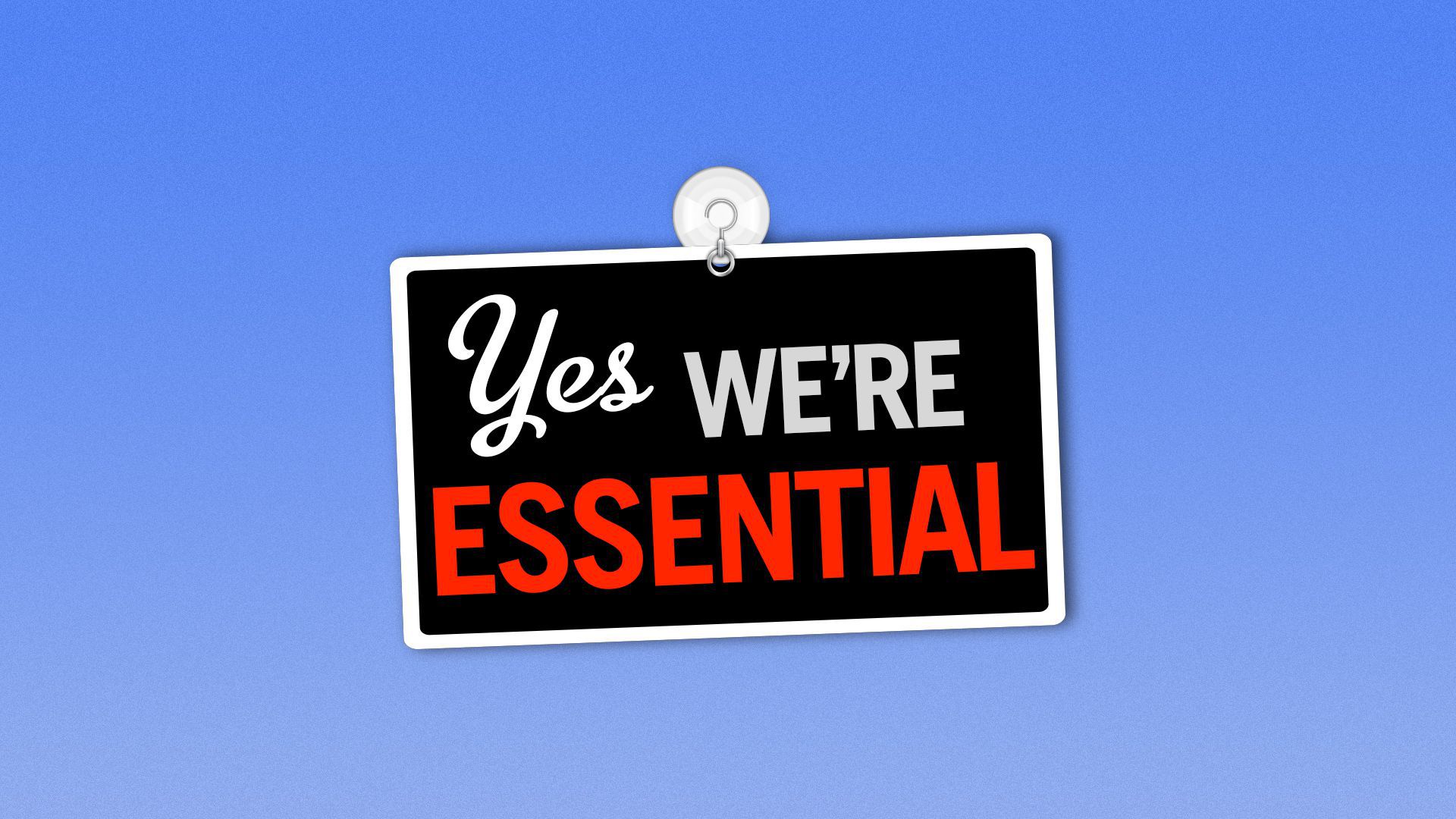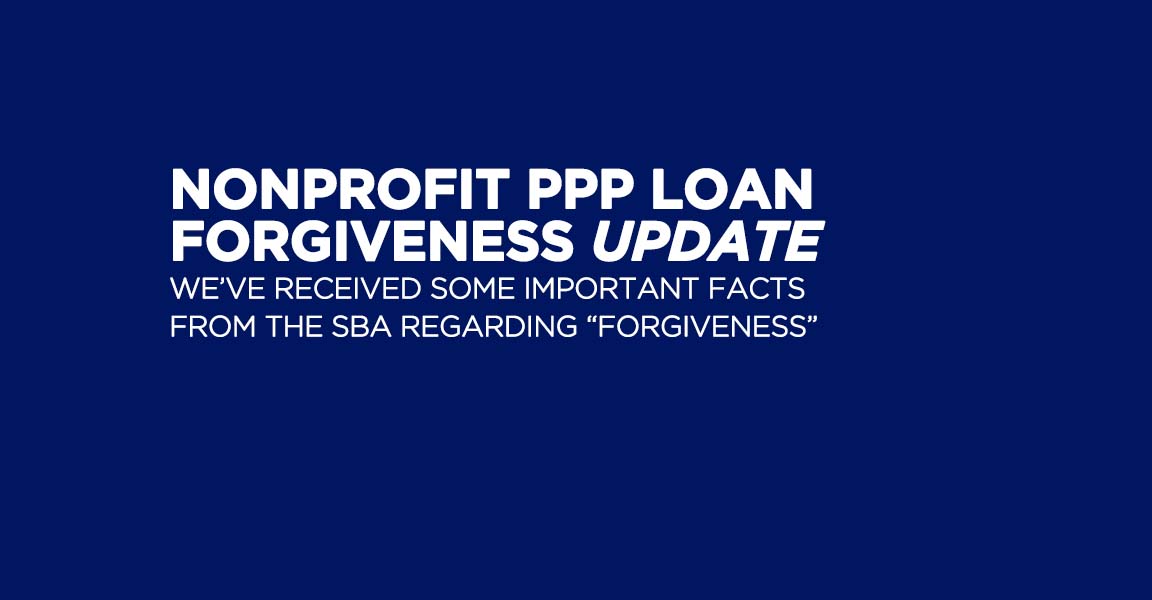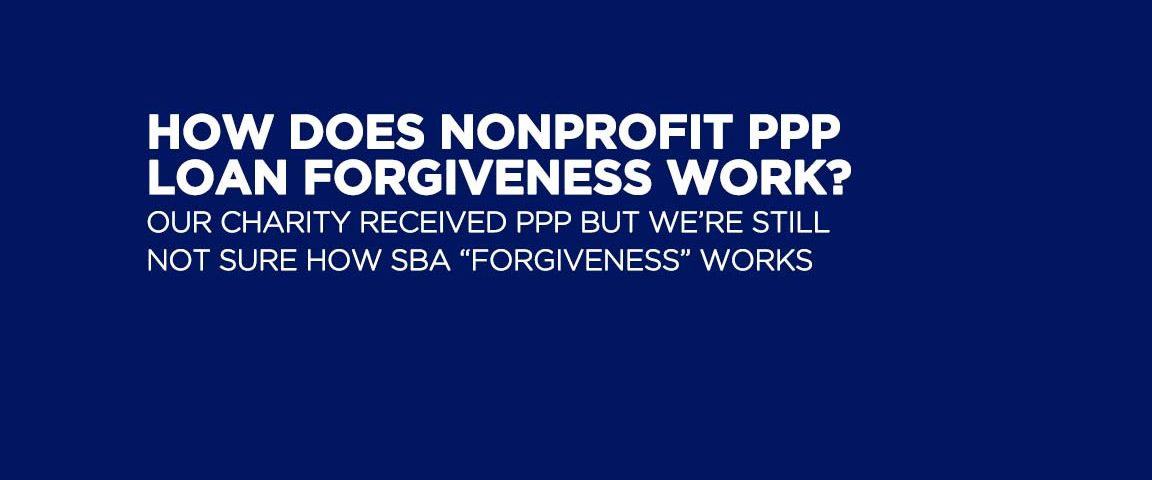
Nonprofits Must Be Ranked Essential – Jim Eskin
May 3, 2020
Nonprofit PPP Loan Forgiveness UPDATE – May 14, 2020
May 7, 2020Nonprofit PPP Loan forgiveness – How Does it Work? – May 4, 2020

Nonprofit PPP Loan forgiveness – How Does it Work? is based on Inside Charity’s direct communications with the Small Business Administration and multiple financial lenders. Here’s what we’ve learned so far.
Beyond the ease of qualifying and low interest rates, perhaps the most attractive feature of Paycheck Protection Program (PPP) loans is that they are eligible for “forgiveness.” This means that the lender can release the borrower from the obligation of repaying the balance. In other words, borrowers can get up to 2.5 times their monthly payroll costs without paying a cent.
(If you’re not yet up to speed on what PPP loans are, read one of our many articles on the program to get caught up.)
However, “free” money is seldom unconditional. For example, if you’ve received PPP loan funds, you must apply for forgiveness within 90 days after the eight-week loan term. Applications for forgiveness will not be accepted after that period.
PLEASE NOTE: The Small Business Administration HAS NOT provided the ACTUAL APPLICATION TO BE USED FOR LOAN FORGIVENESS. (Don’t be surprised if there’s confusion early on!)
SUBSCRIBE HERE to receive “SBA LOAN FORGIVENESS APPLICATION” as soon as it’s released.
Once you’ve applied for and received a PPP loan, you must spend the loan on approved expenses in order for it to be eligible for forgiveness. Luckily, the loans are intended to help with payments many business owners are struggling with right now, including:
- Payroll costs (more on what this means in the next section)
- Interest for mortgages and certain debt*
- Business rent obligations*
- Business utility payments
- Health care benefits
- Additional wages to account for the reduction in tips for tipped employees
*Mortgages and lease agreements must have been signed before February 15, 2020. Interest on debt must also have been incurred prior to February 15, 2020.
If you use any part of your PPP loan for expenses not on this list, that amount cannot be forgiven. Also note that only 25% of your loan funds can be used for the non-payroll costs mentioned above if you want the full loan amount to be forgiven.
Finally, in order to qualify for full loan forgiveness, you must maintain your employee headcount and their compensation levels. If you’ve made any staffing or wage reductions between February 15, 2020 and the end of the eight-week period following disbursement of your loan, you have until June 30, 2020 to rehire employees and restore salary levels. Otherwise, your forgiveness amount will be reduced.
There are many things in the forgiveness process that still require clarification from the government so you should check regularly for updates and always confirm with your lender for their specific requirements.
What costs are included under forgivable payroll costs?
Forgivable payroll costs include:
- Salary and wages — capped at an annual sum of $100,000 (prorated to the eight-week period) for each employee
- Paid time off and leave, including costs for paid vacation and parental, family, medical, or sick leave
- Note: If you’re using credits from the FFCRA for any of the above, those amounts are not eligible for forgiveness.
- Employee benefits, including group health insurance premiums and payment of any retirement benefit
- This includes:
- Health insurance plans
- Dental and vision plans
- Health FSAs
- HRAs (but NOT QSEHRA)
- This does not include:
- HSAs
- Group term life plans (as long as there are no ancillary benefits for medical care)
- Long-term and short-term disability plans (again, as long as there are no ancillary benefits for medical care)
- Commuter benefits
- This includes:
- State and local taxes
- Note: you may not be able to get forgiveness for the employer’s share of FICA, RRTA, or federal income taxes reported on Form 941.
What info do I need to include in my application for loan forgiveness?
In your application for loan forgiveness, you must document the following:
- A record of the number of full-time employees and pay rates your business maintains during the eight-week loan period, via the following documentation:
- payroll tax filings with the IRS
- state income, payroll, and unemployment insurance filings
- Proof of payment, including cancelled checks, receipts, and other documentation that verifies payments for mortgage, lease, and utility payments
- A certification that all the information you provide is accurate and that your loan was used to retain employees, or make rent, mortgage, or utility payments
You should check with your lender to determine if any additional information is required.
What do I need to do to get my loan forgiven?
Step 1: Keep track of your spending during your eight-week loan term.
During the eight-week period after your loan is disbursed, track everything you spend your PPP funds on. Make sure the items map back to the list of forgivable expenses, and track how much you’re spending on non-payroll costs to get an idea of how much of your loan will be eligible for forgiveness (try to keep it under 25% of the full amount you spend).
If you’re a Gusto customer, use the PPP forgiveness reporting tool in your dashboard to see how much of your loan amount is going towards qualifying payroll expenses.
Step 2: Prepare your payroll report.
At the end of the eight-week period, use your federal and state payroll tax filings to prepare a report of all your eligible payroll expenses, including employer contributions to health plan premiums and unemployment insurance. Your financial advisor or payroll provider can help you prepare this report.
Step 3: Gather documentation for non-payroll expenses.
Collect proof of payment for your qualifying non-payroll expenses, like rent, mortgage interest, utility payments, owner compensation, and so on.
Step 4: Submit your forgiveness application to your lender by the deadline.
Check with your lender to see if they require anything else in order to get your loan forgiven. Once you’ve fulfilled all their requirements, submit your forgiveness application to your lender with the proper documentation within 90 days after the final day of your eight-week loan term.
SUBSCRIBE HERE to receive “SBA LOAN FORGIVENESS APPLICATION” as soon as it’s released.
What would reduce the amount of my loan that’s forgiven?
If, during the eight weeks following disbursement of your loan, your business reduces wages or the number of employees compared to a look-back period, the amount forgiven will be reduced. In order to have rehired employees count in your report, you must run a payroll that includes any rehired employee before generating your payroll report.
There is a clause in the CARES Act that says as long as you rehire your employees and restore wages by June 30, 2020, reductions of your forgiveness amount can be waived. Guidance on that clause has yet to be released, so check back here and with your lender for updates.
If you spend more than 25% of your loan on non-payroll costs, you may not be eligible for forgiveness. Guidance has not been released on the consequences of failing to meet this requirement, so it’s also a good idea to consult with your lender on this.
If you’re unable to uphold the loan forgiveness requirements, don’t worry—your loan payments will still be deferred up to six months.
What if I’ve already had to lay off employees—can I still get loan forgiveness?
If you’ve let go of employees or reduced their wages between February 15, 2020 and the end of the eight-week period following the disbursement of your loan, you have until June 30, 2020 to rehire employees and/or reverse any pay cuts to prevent your loan forgiveness amount from being reduced.
Fair warning, the Small Business Administration (SBA) and the Treasury have not yet issued guidance about how this works, so this requirement may change in the future.
When will I find out if my loan was forgiven?
All lenders have 60 days from that date that you apply for forgiveness to decide whether or not you qualify. If any portion of your loan is not forgiven, those amounts must be repaid within two years. As a bonus, any forgiven loans will be excluded from gross income for tax purposes.
If my loan isn’t forgiven, how do I pay it back?
In cases where your PPP loan isn’t forgiven, make arrangements directly with your lender to repay the loan.
Nonprofit PPP Loan forgiveness – How Does it Work? was first posted at INSIDE CHARITY
For more articles like Nonprofit PPP Loan forgiveness – How Does it Work? VISIT HERE
Nonprofit PPP Loan forgiveness – How Does it Work? and other INSIDE CHARITY content and comments are for informational purposes only, you should not construe any such information or other material as legal, tax, investment, financial, or other advice. All content on this site is information of a general nature and does not address the circumstances of any particular individual or entity. Nothing on this site constitutes professional and/or financial advice, nor does any information on the site constitute a comprehensive or complete statement of the matters discussed or the law relating thereto.

10 Comments
If our non-payroll costs are more than 25%, will nothing be forgiven, including payroll, or only the expenses above 25%?
I work for a non profit and since we now have to work from home, I have been averaging approx 36 hours a week, vs 40.
My employer, to keep me at 40 hours a week, has been using my vacation time to make up the difference.
In order to qualify for loan forgiveness, will they be required to reinstate the vacation time they have been using to make up my hours?
How loan forgiveness is calculated if part if the payroll cost is covered by government contacts that are funding the programs of a non profit organization?
WE HAD TO CLOSE OUR THRIFT STORE AND LAY OFF THREE OF OUR OUR EMPLOYEES. WE HAVE RECEIVED OUR PPP MONEY AND WOULD LIKE TO REINSTATE THE EMPLOYEES. THE THRIFT STORE IS NOT OPEN YET, WE ARE WAITING FOR OUR GOVERNOR TO GIVE US THE GREEN LIGHT TO OPEN THE STORE. CAN WE USE THE PPP MONEY TO REHIRE THE EMPLOYEES? THE STORE IS NOT CONSIDERED AN ESSENTIAL BUSINESS.
I received a call this morning from a subscriber asking the following question. Where can I find this information within the Cares Act: “if you’ve received PPP loan funds, you must apply for forgiveness within 90 days after the eight-week loan term.”
Here’s our citation: https://www.forbes.com/sites/brianthompson1/2020/05/04/what-you-can-do-now-to-maximize-paycheck-protection-loan-forgiveness/#253eed643efc
Remember, you must apply for forgiveness within 90 days of the end of the eight-week period. Lenders have 60 days from the date you apply to decide whether you qualify. It’s also important to note that you are not allowed to deduct any expenses you paid the forgivable funds with. Whatever is not forgiven is paid back at a 1% interest rate.
If a non-profit receives grant money to pay employee salary expenses can the non-profit still claim the payroll expense for PPP loan forgiveness?
Bonnie,
It is our limited understanding that the answer to your question is “yes.”
Hi, can you point us to the guidance on why QSEHRA disbursements do not qualify for forgiveness? Thank you!
This blog provides valuable information about PPP loan forgiveness for nonprofit organizations. It’s important for nonprofits to understand the loan forgiveness process to make the most of the financial support they received during challenging times. Thanks to the authors for sharing this helpful resource!